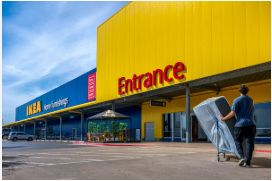More Americans may discover that the square footage they visit in retail stores aligns with this “reduction” ethos when they hunt for bargains during the Christmas season, when many customers believe that less is more.
Ikea is well-known for its enormous, blue and yellow large box stores, which frequently occupy 300,000 square feet in suburban areas. However, they became the most recent in a long line of merchants to adopt a smaller-is-bigger approach when they launched an 8,800-square-foot store in Gaithersburg, Maryland, earlier this year.
Over the past ten years, Target, Macy’s, Nordstrom, and other retailers have experimented with small size stores. Kmart’s Miami location, the only one left in the United States, is just one-third the size of its once-dominant large boxes.

Smaller format trials by chain shops date back at least to 2011, when Walmart launched the “Walmart Express” concept to take on dollar stores. However, the concept was scrapped five years later. Walmart has kept creating Neighbor Market ideas in smaller formats.
Ikea sees its smaller size stores as a means of reaching its target audience. This autumn, two additional smaller-format Ikea stores opened, bringing the total to eleven: one in South Charlotte, North Carolina, and another in Alpharetta, Georgia.
An Ikea representative stated that the smaller stores provide a more individualized experience. “A Plan and Order point with Pick-up is one of many new format stores that are part of the growth strategy for Ikea U.S.— increasing accessibility to the brand and ensuring there are more ways to meet customers where they are and how they like to shop,” the spokesperson said.
The spokesperson mentioned tasks like bathrooms and kitchens and stated, “It is different from the traditional large-format Ikea stores because it gives customers the opportunity to meet with the Ikea store team to plan and order home furnishing solutions that require a bit more help.”
Target, which is facing significant challenges in the market for discretionary consumers, is expanding and contracting at the same time. Last year, it opened a few stores that were 135,000 square feet in size, which is larger than its usual footprint of 125,000 square feet.
It has also been opening smaller stores since 2016. Ten stores with 20,000 square feet or fewer were opened in 2024; these were mostly located in cities or in the residential regions around college campuses.
A Target representative stated that the company will keep opening stores of both sizes, saying, “Our flexible model allows us to bring the Target experience to life in any size or format.”
Increasing sales per square foot of the store
Roger McMahon, a retail specialist and marketing professor at Pepperdine University’s Graziadio Business School, is not surprised by shrinking storefronts. He claims that although the present trend of reducing stores has been going on for decades, it is accelerating. The transition to internet buying started in the 2010s, and the pandemic hastened it.
“Retailers have been frantically trying to figure out what to do. It’s interesting to note that studies reveal that the majority of in-store shopping excursions start online and frequently end there. It is not an either/or situation as a result. In addition to permitting this behavior, brands must figure out how to do so in a way that maximizes their KPIs, McMahon stated.
The amount of money earned per square foot is one of those crucial indicators. To make money per foot, a huge space has to put in a lot more effort.
“When we consider the structure of the large-format stores, the shift to smaller stores makes sense. In the hopes that more time spent in the shop would result in more purchases, the big format features expansive aisles, displays that are widely spaced, and sections intended to invite customers to rest and unwind. Accordingly, a sizable portion of square footage does not immediately provide any income, McMahon stated.
Smaller businesses, however, may also make a client feel “cozier” while providing the merchant with what they desire: higher foot traffic.
According to McMahon, “properly merchandised smaller format stores can increase the revenue generated per square foot and create a more intimate shopping experience, so it’s a win for both the company and the customer.” According to him, “that connection will ideally translate into more online sales for the brand and a more devoted customer base in addition to more brick-and-mortar sales.”
However, customers have differing opinions on whether less is truly more. “I love the little Walmart local markets! Excellent for picking up a few things and doing a fast run-in. Mary Rhodes, a native of Texas, states, “I never go to the smaller Targets anymore because they just don’t have everything that I need.”
Barbara Snedegar, a resident of Cincinnati’s eastern suburbs, on the other hand, like the assortment of bigger retailers. “I really support one-stop shopping. Snedegar remarked, “I’m not so sure about the smaller stores.”
As malls have become earnings anchors, Macy’s mall anchor shops have suffered. The chain demanded earlier this year that 30% of its failing locations be closed. With smaller format locations for both their Macy’s and Bloomingdale’s brands, Macy’s has been attempting to break away from the mall. Macy’s and Bloomie’s Market are scaled-down counterparts of their classic department store designs.
Placer.ai data demonstrates the appeal of decreasing to grow. “Retailers frequently discover that they don’t need the same size to accommodate these customers as a result of consumers moving to smaller suburban and rural markets across the U.S. in recent years,” says R.J. Hottovy, head of analytical research at Placer.ai.
According to Placer.ai’s analysis of traffic to the Bloomie’s shop in Skokie, Illinois, its customers are more likely to be from metropolitan regions than regular Bloomingdales.
According to Hottovy, this suggests that Bloomie’s appeals to city people, which is consistent with Bloomingdale’s mission to offer a modern, easily accessible, and convenient shopping experience in metropolitan locations.
According to Michael Zakkour, CEO of retail consultancy 5 New Digital, it’s all about being everything to everyone while stores grow and shrink simultaneously.

According to Zakkour, “consumers have one overriding demand today.” “Don’t spoil it for me. If not, they will look for the brand, store, and service provider that will spoil them,” he stated. He went on to say that spoiling the customer requires careful consideration of the format.
However, that “spoil” component doesn’t always imply luxury and doesn’t even necessitate physical presence.
“Intelligent retailers must provide varied options and choices in physical retail, just as the options for where and how to buy online have grown exponentially,” Zakkour stated, noting examples like Walmart’s expansion of commerce into Roblox and into livestream purchasing with REALM.
The smaller storefronts provide an opportunity for companies like Ikea, who usually construct expensive huge boxes, to set up shop for a fraction of the price.
According to Zakkour, “these stores help spoil the consumer; they show that the retailer is loyal to their needs and can act as mini-flagships and forward operating bases for local deliveries.”





